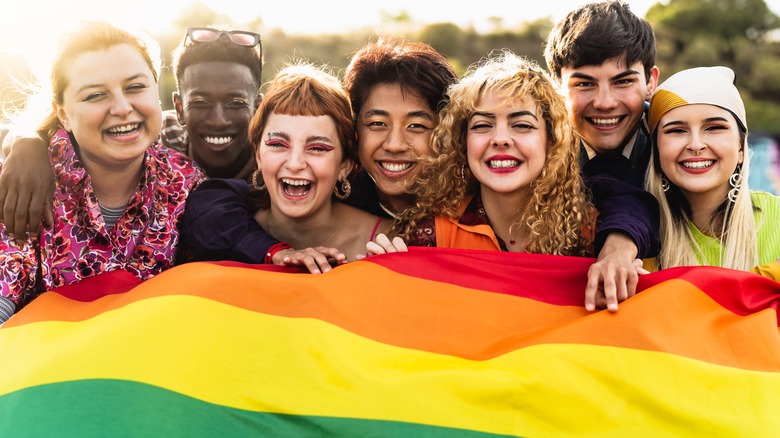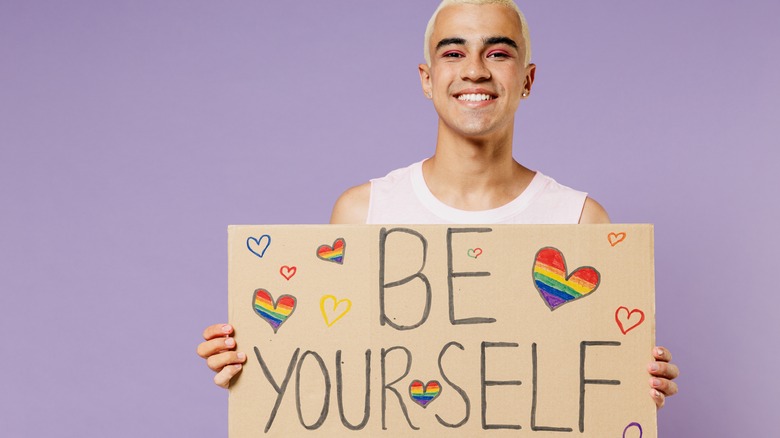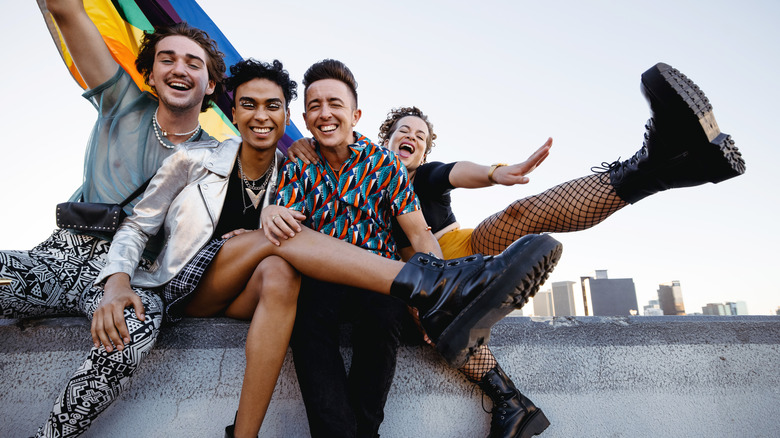What's The Difference Between Being Pansexual And Bisexual?
The term "bisexual" has been around since the 1700s, however, back then, it meant someone of two genders. By the 70s, the term was "sensationalistically" used, Loraine Hutchins, a writer and editor, told NBC News. She also said, "sexuality research on 'the B word' was rare." But by the 90s, the Bay Area Bisexual Network published the "Bisexual Manifesto," which finally gave a strong definition for the world. And from then on, the identity "bisexual" has become more widely used and understood. However, there are still a lot of misconceptions, and with the creation and rise of the label "pansexual," it can be even more confusing to what the differences between them are and which term best defines you.
Both bisexuality and pansexuality fall under what's called the "bisexual umbrella," or even sometimes referred to as "bi+," per Gay Times. This is because both sexualities have the capacity and potential to find attraction (sexual or romantic) to multiple genders. They are two separate sexualities with "no straightforward difference," according to Insider.
Due to the fact that there is a thin line between the two sexualities, both bisexuals and pansexuals have similar experiences of higher levels of homophobia and discrimination, even from within the queer community. So, how do you define the differences that aren't very apparent? It really just boils down to how one wants to personally identify.
Bisexual isn't outdated and doesn't mean bisexuals only like two genders
Contrary to, unfortunately, a lot of misinformation in the social media age, bisexuality isn't outdated and isn't inherently transphobic. As Gay Times writes, a "bisexual" is someone who has "sexual/romantic attraction to more than one gender." Another way to think of it is an attraction to your gender and others. Robyn Ochs, a prominent bisexual activist and writer of the original bisexual manifesto, has defined bisexuality since the '90s as the "potential to be attracted — romantically and/or sexually — to people of more than one gender, not necessarily at the same time, not necessarily in the same way, and not necessarily to the same degree."
Just like "bilingual" doesn't mean that a Spanish-English speaker only believes in those two languages, being bisexual doesn't mean that someone believes in the gender binary (aka strictly male and female). But as with all things regarding sexuality and gender, bisexuality is different for everyone. You can experience greater attraction for one or more genders than another, and you can still identify as bisexual.
Martin Rawlings-Fein, a transgender man and former lead organizer for the Bay Area Bisexual+ & Pansexual Network, told NBC News even he initially saw the term as "limiting," but meeting trans and genderqueer bisexuals changed his opinion. "I started looking at all of those people who were bi at that time," he said. "I was like, 'Wow, this is something I have to rethink and look at, reframe it.'"
Pansexuality is all about attraction not tied to gender
Pansexuality means "sexual desire or attraction that is not limited to people of a particular gender identity or sexual orientation," according to Merriam-Webster. According to Rolling Stone, the prefix "pan" is Greek and means "all." They wrote that the term "pansexual" arose out of confusion from some in the LGBTQ community about what "bisexual" means. Again, the notion that "bi" excludes nonbinary and trans people and creates an archaic gender binary is untrue, but "pan" is an identity some choose to go with for the sake of "definitive" inclusivity in their sexual identity.
Again, the concept of "hearts not parts," a common pansexual phrase, is a bit outdated or not accurate in and of itself. It insinuates that other bi+ sexualities, such as bisexuals, care about what's in someone's pants on the first date. That's not the case and is almost trans-exclusionary in its messaging. Ethan Remillard told Rolling Stone, "I identify as bisexual because I like f***ing dudes and romancing girls. But I don't claim pansexuality because trans[gender] girls and boys are the same as their cis[gender] counterparts." Instead, possibly a better way to look at pansexuality is when someone is drawn in by someone's "vibes" while not taking in gender or gender expression at all. Bisexuals can also date and experience attraction in this way too, but again that's why it's up to each person how to identify. There's no right or wrong label.
How to choose between bisexuality and pansexuality
Bisexuality and pansexuality are valid labels chosen by the user, no one else. Both have the potential to be attracted to multiple genders. Bisexuals often go with the label because of its history and well-known meaning. Pansexuals often choose the label they believe better presents to the world who they are because of its finality. Bisexuality doesn't exclude nonbinary and transgender people — it never has — and pansexuality isn't an evolved label for what bisexuality was.
Again, both experience a higher level of homophobia than others. When it comes from within the queer community, this discrimination is often due to the belief that bi+ people aren't "queer enough" because of their potential to be in "straight-passing relationships." As Tania Israel, a psychology professor specializing in LGBTQ health at UC Santa Barbara told The New York Times, "The more anti-bisexual experiences someone has, the worse their health can be." A 2017 review found that "bisexual people had higher rates of depression and anxiety" than straight people and "higher or equivalent rates of those conditions" than people who identify as gay.
When it comes to being on the fence about one of these labels, some questions you can ask yourself include, "Are there any genders I never feel an attraction for?" or "Which word feels better to me?". At the end of the day, though, your identity is yours alone. Using whatever label(s) make you feel like you is the most important thing.



